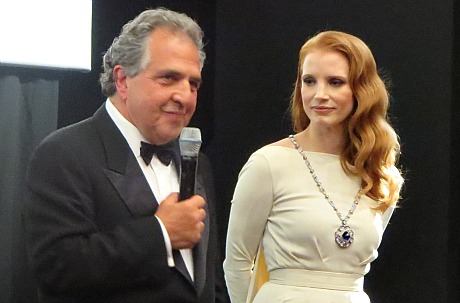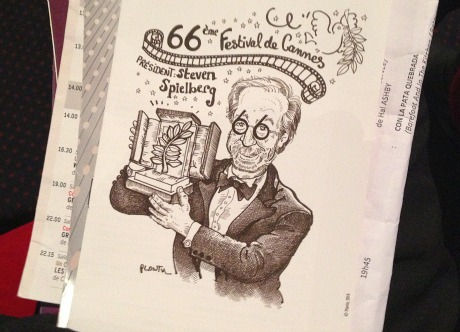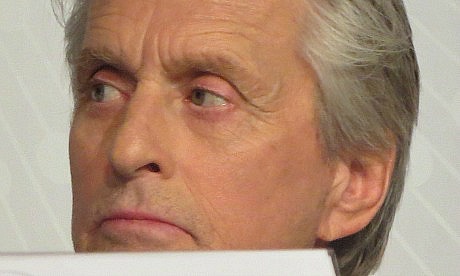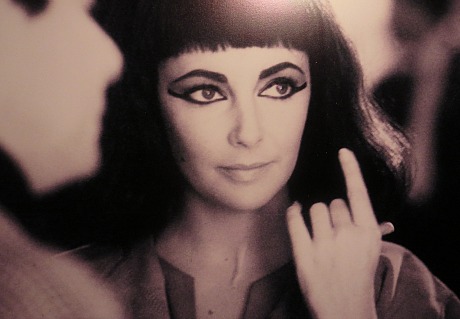This morning’s 8:30 am screening is Nicholas Winding Refn‘s Only God Forgives, which at least seems to promise a world-class Kristin Scott Thomas performance. Ryan Gosling reportedly wont be here for the 11 am press conference — he’s directing his first film and can’t get away. I’m also catching Mahamat-Saleh Haroun‘s Grigris at 4 pm. And J.C. Chandor‘s All Is Lost (hors competition) at a 7:30 pm black-tie Salle Bazin screening followed by an after-party.
Cleopatra Peek-In
For whatever reason Jessica Chastain, here in Cannes on a promotional venture I’ve yet to learn the nature of, was asked by Fox Filmed Entertainment chairman & CEO Jim Gianopulos to offer a few remarks before tonight’s Salle du Soixantime screening of the digitally restored Cleopatra (’63). Nebraska director Alexander Payne also attended the black-tie event, along with Laura Dern (are they “happening” or are they just pallies based on Dern having starred in Payne’s Citizen Ruth way back when?).


Fox Filmed Entertainmetn chairman & CEO Jim Gianopulos, Jessica Chastain at Salle du Soixantieme earlier this evening.

Decapitated Giraffe
“At times it’s debatable whether The Hangover Part III should even be considered a comedy at all, as it more often plays like a loopily plotted, exposition-heavy actioner. Despite a career-long devotion to lowbrow comedy, director Todd Phillips displays a deft touch for the various jail breaks, heists and car chase sequences that arise here, while the film’s attempts at basic comic banter wither on the vine. One wonders how he would fare directing a straight genre project in which he could use dark humor to spice up the action beats, rather than the other way around.” — from review by Variety‘s Andrew Barker.
Max Rose Sampler
Password: maxrose.
Oh, Those Muttonchops
James Mangold was the crown prince when Walk The Line came out and rocked in ’05. And then came 3:10 to Yuma, which I remember more for its frustrations than satisfactions. And then Knight and Day, which I recently re-saw and liked a lot more than I did the first time. And now his Wolverine-in-Japan movie, the third genre flick in a row. The next one has to step off that treadmill.
Candelabra Counts
Of all the major directors of the past 20 years, Steven Soderbergh has always seemed the least emotional. His movies certainly never take a bath in the stuff. So it doesn’t sound like much to call Behind The Candelabra (HBO, 5.26) his most emotional and touching work. But I don’t mean it lightly. This HBO movie (which will play theatrically in Europe) truly touches bottom and strikes a chord. It’s a sad (but not glum or downish), movingly performed drama about a kind of marriage that begins well and then goes south after five years. Richard LaGravanese‘s script is complex, fleshed-out and recognizably human at every turn, and performed with considerable feeling and vulnerability by Michael Douglas (easily the top contender right now for a Best Actor prize) and Matt Damon.

Behind The Candelabra star Michael Douglas during this morning’s Cannes Film Festival press conference.
Little Split Screen Action
In the view of Indiewire‘s Boyd Van Hoeij (how do you pronounce that?), James Franco‘s As I Lay Dying is “just passable,” which raises the question of whether this adaptation of William Faulkner’s 1930s novel “deserves[s] the honor” of playing under the Cannes Film Festival’s Un Certain Regard.
Pic is “not only an admittedly small-scale period movie but, at the same time, an ambitious artistic project on the more experimental end of the arthouse spectrum, with a good portion of the widescreen film divided up in split-screen, offering possibilities such as side-by-side shot/reverse shots; simultaneous wide shots and close-ups and fascinatingly merged or altogether new soundscapes.”
Sounds of Satan
I was about to step on-board the Lady Joy and join the party for James Toback‘s Seduced and Abandoned, but I couldn’t stand listening to the GODAWFUL DISCO HAMMERHEAD MUSIC playing at the party next door. Can you imagine being a party DJ and actually playing this crap with the presumption that people would actually want to hear it? I was kept standing on the dock for 20 minutes because I arrived at 11:10 for a party that began at 11:30 pm. And all during that time I was getting more and more sick of listening to these DROOLING VAMPIRE FANG DEMON HELL FART SOUNDS. By the time it was cool to go onboard I was all but throwing up. I escaped.
Lacquered, Lustrous Bellezza
Paolo Sorrentino‘s La Grande Bellezza (The Great Beauty) is not just a return to the highly stylized realm of Il Divo, but a channelling of Federico Fellini‘s 8 1/2 and La Dolce Vita with perhaps a few sprinkles of Fellini Satyricon. It’s a contemporary Roman dream fantasia, familiar and picturesque and deliciously unreal, that serves as a kind of meditation or spiritual journey piece about a 60ish good-time-Charlie journalist (Toni Servillo) trying to cut through the crap and clutter of his life and perhaps get beyond regarding everything and everyone with a smirk and rediscover something sacred…a sense of purpose or connectivity, God, love, or a yen to write books again.
Midday Davis Schmooze
I did a 25-minute interview with Seduced and Abandoned James Toback in his Carlton hotel room this morning (to be posted later), and around 12:45 pm I attended a fairly exclusive Inside Llewyn Davis luncheon and round-table session. Joel and Ethan Coen, Oscar Isaac, Carey Mulligan, Justin Timberlake, musical director T-Bone Burnett, director of photography Bruno Delbonnel. And that’s all so far. Paolo Sorrentino‘s La Grande Bellezza starts at 7 pm.

(r.) Inside Llewyn Davis director of photography Bruno Delbonnel; (l.) director-writers Joel and Ethan Coen.

10-inch vinyl of four or five Inside tracks.
Five Days Left
I was going to give Takashi Miike‘s Straw Shield (Wara No Tate) a try, but a colleague told me it wasn’t reviewed all that favorably when it opened last month in Japan. So due respect but I guess not. I’ve got a James Toback interview at the Carlton 11 am and then an Inside Llewyn Davis press luncheon/roundtable thing in the same hotel, between 12:45 pm and roughly 2 pm.

Would it be impolite to blow off a portion of the ILD roundtables? Because James Franco‘s As I Lay Dying screens at the Salle Debussy at 2 pm, and if I miss that there’s the 2:15 pm Salle du Soixantime screening of Inside Llewyn Davis, which I really want to see again. There’s a 4 pm of Valeria Bruno Tedeschi‘s Un Chateau en Italie but the big film of the day is Paolo Sorrentino‘s La Grande Bellezza, which I gather is some kind of 21st Century La Dolce Vita. It screens at the Salle Debussy at 7pm, and there’s going to be a crowd.




